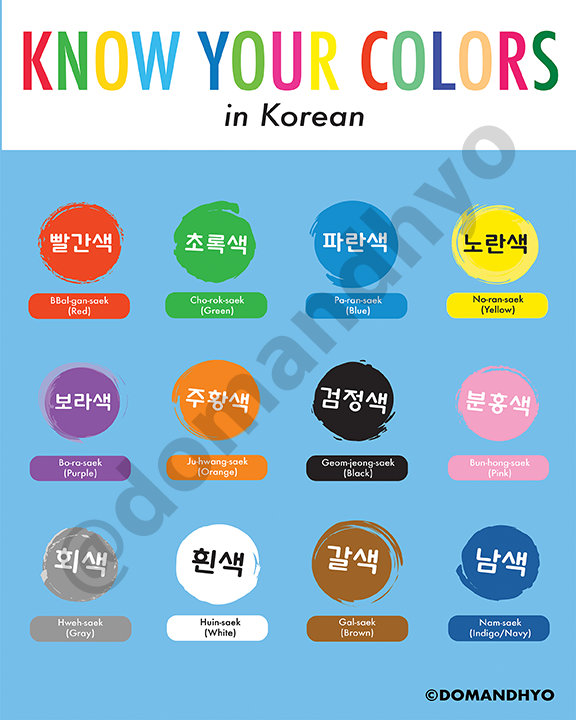

Learning the Korean colors should be one of several things you learn once you start studying Korean. It will help you a lot when you are trying to describe certain things or hear someone else describing something. The basic colors (for instance just the ones on the rainbow) are easy to learn, but there is another level to the colors in which it can get a little confusing (we may cover those laters).
For now, let’s stick to the basics.
Basic colors:
빨간색 (bbal-gan-saek) = Red
초록색/녹색 (cho-rok-saek) = Green
파란색 (pa-ran-saek) = Blue
노란색 (no-ran-saek) = Yellow
보라색 (bo-ra-saek) = Purple
주황색/오렌지색 (ju-hwang-saek) = Orange
검정색/검은색/까만색 (geom-jeong-saek) = Black
분홍색 (bun-hong-saek) = Pink
회색 (hweh-saek) = gray
하얀색/흰색 (ha-yan-saek) = White
갈색 (gal-saek) = Brown
남색 (nam-saek) = Navy
At the very least, you should know the above. We’ve also added other names that are also used for some of the colors as well. Some of these have variations just like English (dark blue, dark brown, etc.)
Here are some of the other colors:
적갈색 (jeok-gal-saek) = Maroon
연두색 (yeon-du-saek) = Light green
하늘색 (ha-neul-saek) = Sky blue
연노란색 (yeon-no-ran-saek) = Light yellow
연보라색 (yeon-bo-ra-saek) = Light purple
베이지색 (be-i-ji-saek) = Beige
청록색 (cheong-nok-saek) = Turquoise
진분홍색 (jin-bun-hong-saek) = Dark pink
금색 (geum-saek) = Gold
은색 (eun-saek) = Silver
아이보리색 (a-i-bo-ri-saek) = Ivory
밝은 회색 (bal-geun hweh-saek) = Light gray
Meaning of Certain Colors in Korean
Some Koreans ascribe certain meanings to certain colors. For example, green can be considered lucky, black usually symbolizes death, white is for purity and goodness, and red can mean passion (but don’t write names in red! It’s a superstition that this means you will die soon)
On the Korean flag (taeguki), the red and blue are positive (Red) and negative (Blue) forces. White (which has always been an important color throughout Korean history) represents purity and peace.
Happy studying!
You can review and practice these words more with our printable PDF worksheets for beginners here.
